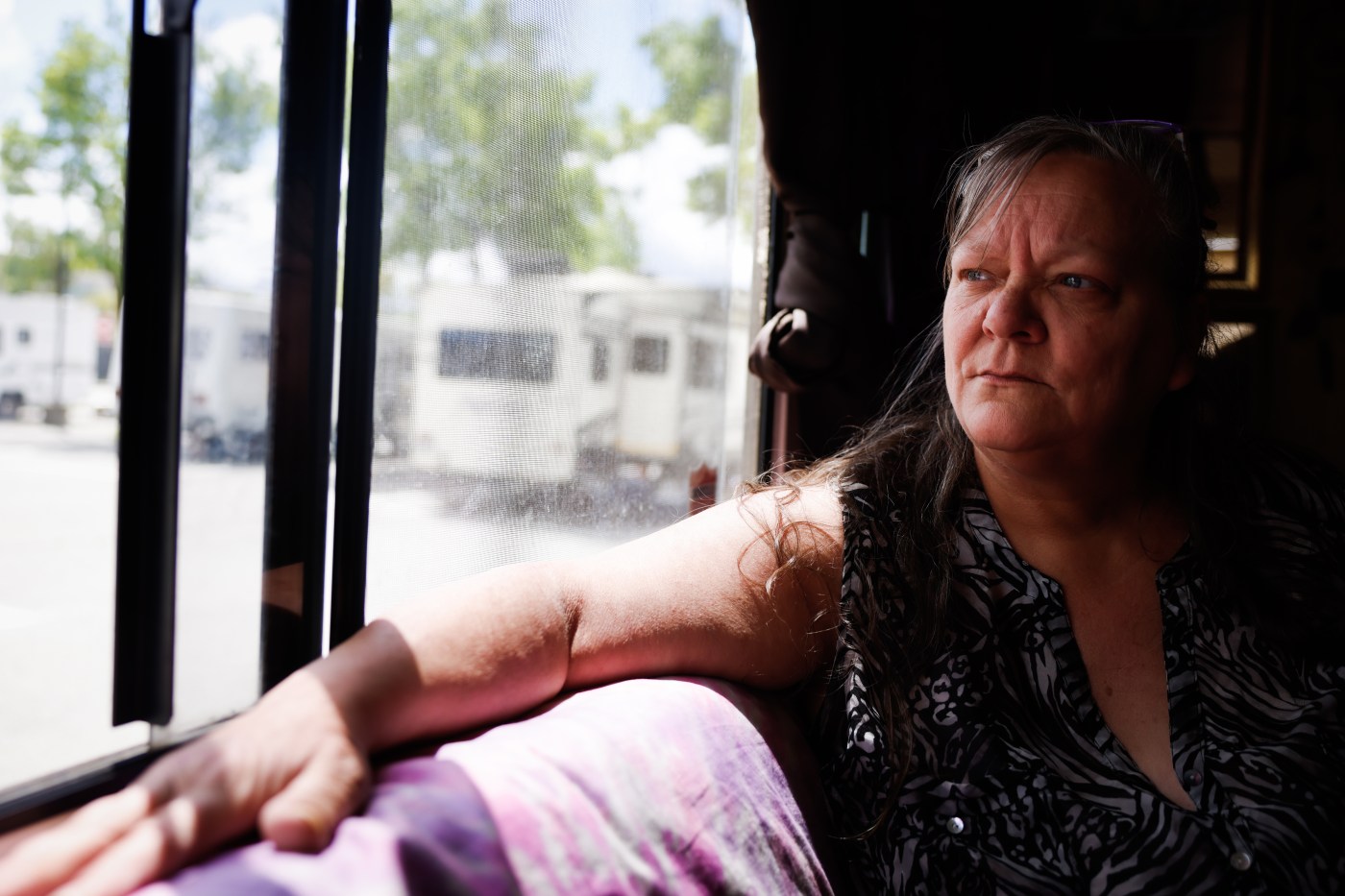After months living out of an RV at a sprawling homeless camp north of downtown San Jose, Heidi White was relieved to move her 1995 Ford motorhome into the city’s first managed 24/7 safe parking lot.
She no longer needed to worry about encampment fires or drug dealing outside her door, and staff running the site atop a tree-dotted lot next to the Santa Teresa VTA light rail station in South San Jose promised to help her find an affordable apartment.
But six months later, White, 56, who lives with her dogs Pumpkin and Jake, said she’s no closer to securing a lasting home. While she and around 10 other vehicle dwellers said they’re thankful for having a safe place to stay, they described feeling stuck at the lot, without a clear plan for what comes next.
“They brought us here under the pretext that they were going to help us get out of our RVs and get into homes,” White said.
As residents grow increasingly frustrated with an estimated 700 lived-in RVs scattered across San Jose’s streets and parks, the city is among the latest in the Bay Area to turn to safe parking lots — while also adopting tougher restrictions on oversized vehicles parked on city streets.
City officials have pitched the sites — which provide utilities, security and case management — as a fast and cost-effective way to help people off the street and into permanent homes. But with a severe shortage of affordable housing in the region, most VTA lot residents have been waiting at the site for months.
According to the city, just seven of the 55 households that have stayed at the 42-space lot since opening last July have found lasting homes. Three moved to shelters, and three voluntarily returned to the street. The rest remain at the site, which has no strict time limit on stays.
The VTA lot — and a second site in North San Jose for up to 85 RVs set to open this fall — have also faced delays and neighborhood opposition, underscoring the challenges of giving homeless people refuge at public parking lots as officials seek to expand sites citywide.
Related Articles
A new California bill could provide cash to homeless high school seniors
Affordable housing project with 64 units for homeless people opens in downtown San Jose
Walters: Newsom critical of California’s local response to homelessness. Look in the mirror
As budget cuts loom, Bay Area big city mayors urge Newsom to spare homelessness funding
3 California boys charged with assault after homeless man is beaten with poles and a tripod
Mayor Matt Mahan said while he wants to see safe parking residents find housing, the city’s immediate goal should be helping people off the street and out of harm’s way.
“We need to build a lot more housing,” he said. “In the meantime, the first measure of success is how many people are unsheltered in the community.”
Last year, the number of homeless people living outdoors or in vehicles in San Jose dropped more than 10% to an estimated 4,440. Mahan attributed the decline to the hundreds of tiny home shelters the city has erected in recent years. He said scaling up safe parking can further lower that number.
Nonetheless, people staying at shelters and managed parking lots are still considered homeless. Critics argue that as the city has shifted millions of dollars in funding from permanent housing to less expensive shelter options, local officials are losing sight of their priorities.
“It’s not a surprise that people aren’t able to move out of these temporary shelter models into permanent housing because the focus has largely been diverted to temporary measures,” said Jennifer Loving, chief executive of Silicon Valley homelessness solution nonprofit Destination: Home.
Loving also worries that a newly adopted RV parking policy allowing the City Council to create “no overnight parking zones” will lead to a surge in impounded vehicles. With the ordinance set to take effect in May, Destination: Home started a fund to pay towing fees so people can reclaim their campers.
In 2019, the Mountain View City Council also adopted a controversial ban on oversized vehicles from many city streets, while also helping open 114 safe parking spaces across five sites. Early results showed that about 30% of people staying there found housing.
LifeMoves, the South Bay nonprofit that manages the San Jose site, also operated a now-closed safe parking program for 40 RVs that Redwood City opened in 2020 after the city agreed to new parking restrictions. The nonprofit said about 60% of households there moved to housing, attributing the higher rate to a recently opened supportive housing facility nearby.
Elsewhere in the Bay Area, Oakland, Berkeley, Walnut Creek and San Francisco have also embraced safe parking.
LifeMoves said it works closely with safe parking residents to navigate housing resources, including signing up for federal housing vouchers. However, the nonprofit said some residents decline to meet with case managers, while others prefer living in their RVs.
“It takes time and real support over multiple touch points for clients to feel secure enough to save money and envision a life beyond vehicle dwelling,” LifeMoves said in a statement.
The VTA site also faced months-long construction delays, and the planned North San Jose lot in the Berryessa neighborhood has also fallen behind schedule, frustrating some City Council members. City officials chalked up the delays to drafting contracts, working with utility agencies and ensuring site habitability.
Related Articles
A new California bill could provide cash to homeless high school seniors
Affordable housing project with 64 units for homeless people opens in downtown San Jose
Walters: Newsom critical of California’s local response to homelessness. Look in the mirror
As budget cuts loom, Bay Area big city mayors urge Newsom to spare homelessness funding
3 California boys charged with assault after homeless man is beaten with poles and a tripod
Completing the Berryessa site is expected to cost around $7.5 million. At the VTA site, which also cost millions to set up, operating expenses are around $1.5 million a year, officials said.
Additionally, city requirements that vehicles are registered and operable kept the VTA site mostly empty for weeks after it opened. Officials said they’ve since begun helping people fix and register their vehicles before moving in.
Another, perhaps inevitable, challenge? Residents opposed to safe parking lots in their neighborhoods.
Before the City Council approved the Berryessa site last June, a half-dozen residents protested outside City Hall, holding up signs reading “Keep our children safe” and “No RV parking in Berryessa.”
Still, Mahan contends the public’s desire to move people off the street outweighs concerns about safe parking. He said since the new tiny home shelters have opened, “people come up to me months or even years later and say my neighborhood is much better off now.”











